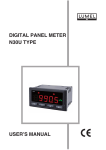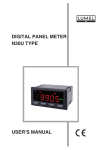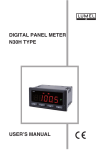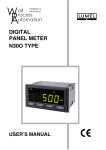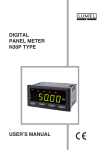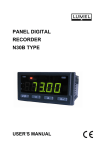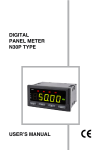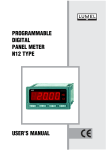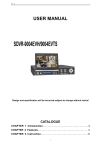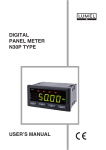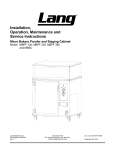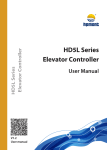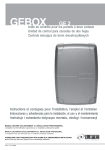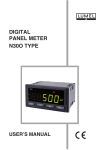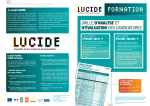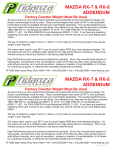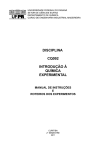Download DIGITAL PANEL METER N30U TYPE USER`S MANUAL
Transcript
DIGITAL PANEL METER N30U TYPE USER’S MANUAL Contents 1. APPLICATION AND METER DESIGN.........................................5 2. METER SET...................................................................................6 3. BASIC REQUIREMENTS, OPERATIONAL SAFETY..................7 4. INSTALLATION.............................................................................7 5. SERVICE.....................................................................................11 6. RS-485 INTERFACE...................................................................27 7. ERROR CODES..........................................................................41 8. TECHNICAL DATA.....................................................................42 9. ORDER CODES..........................................................................42 10. MAINTENANCE AND GUARANTEE..........................................44 1. APPLICATION AND METER DESIGN The N30U meter is a programmable digital panel meter destined for measurements of signals originating from standard sensors destined for temperature measurements and for the measurement of analog standard signals applied in automation. Additionally, the meter enables the indication of the current time. The readout field is a LED display, which allows the exposition of results in colours: red, green and orange. The measured input signal can be arbitrary converted by means of a 21-point individual characteristic. Features of the N30U meter: l display colour individually programmed in three intervals, l programmable thresholds of displayed overflows, l 2 NOC relay alarms operating in 6 modes, l 2 switched relay alarms with a switching contact operating in 6 modes (option), l signaling of measuring range overflow, l automatic setting of the decimal point, l programming of alarm and analog outputs with the reaction on the selected input quantity (main or auxiliary input), l real-time clock with the function of the clock supply support in case of the meter supply decay, l programmed averaging time – function of walking window with the averaging time up to 1 hour, l monitoring of set parameter values, l locking of introduced parameters by means of a password, l recount of the measured quantity on the base of the 21-point individual characteristic, l service of the interface with MODBUS protocol in the RTU mode (option), l conversion of the measured value into a standard – programmable current or voltage signal (option), l highlight of any measuring unit acc. to the order, l signaling of alarm operation – switching the alarm on causes the highlight of the output number, l galvanic separation between connections: alarm, supply, input, analog output, output of the auxiliary supply, RS-485 interface. Protection grade from frontal side: IP65 Meter overall dimensions: 96 x 48 x 93 mm (with terminals). The meter casing is made of plastic. Fig. 1 View of the N30U Digital Meter 2. METER SET The set is composed of: - N30U meter.........................................................................1 pc - User’s manual.....................................................................1 pc - Guarantee card...................................................................1 pc - Set of clamps to fix the meter in the panel..........................4 pcs - Set of labels with units........................................................2 pcs - Seal.....................................................................................1 pc When unpacking the meter, please check whether the type and execution code on the data plate correspond to the order. 3. BASIC REQUIREMENTS, OPTIONAL SAFETY In the safety service scope, the N30U meter meets the requirements of the EN 61010-1 standard. Mentioned below applied symbols mean: - especially important , one must acquaint with this information before connecting the meter. The non observance of notices marked by this symbol can occasion injures of the personnel and a damage of the instrument. - One must take note of this when the instrument is working inconsistently to the expectations. Possible consequences if disregarded. Observations concerning the operational safety · All operations concerning transport, installation, and commissioning as well as maintenance, must be carried out by qualified, skilled personnel, and national regulations for the prevention of accidents must be observed. · Before switching the meter on, one must check the correctness of connections. · Do not connect the meter to the network through an autotransformer. · Before removing the meter housing, one must switch the supply off and disconnect measuring circuits. · The meter is designed to be installed and exploited in electromagnetic industrial environment conditions. · When connecting the supply, one must remember that a switch or a circuit-breaker should be installed in the building. This switch should be located near the device, easy accessible by the opera tor, and suitably marked as an element switching the meter off. · Non-authorized removal of the housing, inappropriate use, incorrect installation or operation, creates the risk of injury to personnel or meter damage. For more detailed information, please study the User’s Manual. 4. INSTALLATION The meter has separable strips with screw terminals, which enable the connection of external wires of 1.5 mm2 cross-section for input signals and 2.5 mm2 for other signals. One must prepare a hole of 92+0,6 ´ 45+0,6 mm in the panel, which the thickness should not exceed 6 mm. The meter is adapted to be mounted in a panel. The meter must be introduced from the panel front with disconnected supply voltage. Before the insertion into the panel, one must check the correct placement of the seal. After the insertion into the hole, fix the meter by means of clamps (fig.2). Fig. 2. Meter Fixing Fig. 3. Overall Dimensions 4.1. Lead-out of Signals Signals led out on the meter connectors are presented on the fig. 4. Circuits of successive groups of signals are separated between them. Fig. 4. Description of Signals on Connection Strips · · · · · · 0...10 V – input for the measurement ±10 V voltage, GND – mass for the 0...10 V input and 0...20 mA input, 0...20 mA – input for the measurement of ±20 mA current, 60 mV TC – input for the measurement of 60 mV voltage, or for the connection of RTD sensors, R, PT – input for the resistance measurement or for the connection of RTD sensors. The compensation wire has been marked by a broken line, OC – open collector output of npn type– signaling of the measuring range overflow. 4.2. Examples of Connections An example of the N30U meter connection to different signals is presented on the fig. 5. Fig. 5. Ways of the meter Connection For the connection of input signals in environments with a high noise level, one must apply shielded wires. 10 5. SERVICE 5.1. Display Description Fig. 6. Description of the Meter Frontal Plate 5.2. Messages after Switching the Supply on After switching the supply on, the meter displays the meter name N30U and next the program version in the „r x.xx” shape – where x.xx is the number of the current program version or the number of a custom-made execution. Next, the meter carries out measurements and displays the value of the input signal. The meter sets up automatically the decimal point position when displaying the value. The format (number of places after the decimal point) can be limited by the user. 11 5.3. Functions of Buttons - Acceptation button: Þentry in programming mode (hold down ca 3 seconds) Þmoving through the menu – choice of level, Þentry in the mode changing the parameter value, Þacceptation of the changed parameter value, Þstop the measurement – when holding down the button, the result is not updated. The measurement is still carried out. - button increasing the value: Þdisplay of maximal value, The pressure of the button causes the display of the maximal value during ca 3 seconds. Þentry in the level of the parameter group, Þmoving through the chosen level, Þchange of the chosen parameter value – increasing the value. - Button to change the digit: Þdisplay of minimal value, The pressure of the button causes the display of the maximal value during ca 3 seconds. Þentry in the level of parameter group, Þmoving through the chosen level, Þchange of chosen parameter value – shift on the next digit, - resignation button: Þentry in the menu monitoring the meter parameters (by holding down ca 3 seconds), Þexit from the menu monitoring meter parameters, Þresignation of the parameter change, Þabsolute exit from the programming mode (by holding down ca 3 seconds). 12 The pressure of the button combination and holding them down ca 3 seconds, causes the reset of alarm signaling. This operation acts only when the support function is switched on. The pressure of the sing of the minimal value. button combination causes the era- The pressure of the sing of the maximal value. button combination causes the era- The pressure and holding down the button ca 3 seconds causes the entry in the programming matrix. The programming matrix can be protected by the safety code. The pressure and holding down the button during 3 seconds causes the entry in the menu monitoring meter parameters. One must move through the monitoring menu by means of and buttons. In this menu, all programmable meter parameters are only available for readout. In this mode, the menu Ser is not available. The exit from the monitoring menu is carried out by means of the button. In the monitoring menu, parameter symbols are displayed alternately with their values. The service algorithm of the meter is presented on the fig. 7. Pojawienie się na wyświetlaczach cyfrowych niżej wymienionych symboli oznacza: - Niepoprawnie wprowadzony kod bezpieczeństwa. - Przekroczenie górnego zakresu pomiarowego lub wartoœæ nie mieœci siê na wyœwietlaczu (wartoœæ za du¿a). Pojawienie siê komunikatu mo¿e œwiadczyæ równie¿ o przerwie w obwodzie czujnika. - Przekroczenie dolnego zakresu pomiarowego lub wartoœæ nie mieœci siê na wyœwietlaczu (wartoœæ za ma³a). Pojawienie siê komunikatu mo¿e œwiadczyæ o przerwie w obwodzie czujnika. 13 14 Fig. 7. Service Algorithm of the N30U Meter 5.4. Programming The pressure of the button and holding it down through ca 3 seconds causes the entry to the programming matrix. If the entry is protected by a password, then the safety code symbol SEC is displayed alternately with the set value 0. The write of the correct code causes the entry in the matrix, the write of an incorrect code causes the display of the ErCod symbol. The matrix of transitions to the programming mode is presented on the fig. 8. The choice of the level is made by means of the button, however the entry and moving through the parameters of the chosen level is carried out by means of the and buttons. Parameter symbols are displayed alternately with their current values. In order to change the value of the chosen parameter, one must use the button. For resignation from change, one must use the button. In order to exit from the chosen level, one must chose the ----- symbol and press the button. To exit from the programming matrix, one must press the button during ca 1 second. Then, the symbol End appears for ca 3 seconds and the meter transits to the display of the measured value. In case of leaving the meter in the parameter programming mode, the automatic abandon of the programming mode follows (parameter, and next the menu) after 30 seconds and the meter transits to display the measured value. 5.4.1. Value Change Way of the Selected Parameter In order to increase the value of the selected parameter, one must press the button. A single pressure of the button, causes the increase of the value of 1. The increase of value when displaying the digit 9 causes the set of 0 on this digit. The change of the digit follows after pressing the button. In order to accept the set parameter, one must hold down the button. Then, the write of the parameter follows and the display of its symbol, alternately with the new value. The pressure of the button during the change of the parameter value will cause the resignation of the write. 15 Fig. 8. Programming Matrix. 16 5.4.2. Changing Floating-Point Values The change is carried out in two stages (the transition to the next stage follows after pressing the button): 1) setting the value from the range -19999M...99999, similarly as for integral values; 2) setting of the decimal point position (00000., 0000.0, 000.00, 00.000, 0.0000); the button shifts the decimal point to the left, however the button shifts the decimal point to the right; The pressure of the button during the change of the parameter value will cause the resignation of the write. 5.4.3. Characteristic of Programmed Parameters Programmed parameters and the range of their quantity changes are presented in the table below. Table 1 InP 1 Parameter symbol tYP1 Description Kind of the connected input signal Range of changes Pt1 – Pt100 Pt5 – Pt500 Pt10 – Pt1000 rEZL – measurement of resistance up to 400 W rEZH – measurement of resistance up to 4000 W tE-J – J (Fe-CuNi) tE-h – K (NiCr-NiAl) tE-n – N (NiCrSi-NiSi) tE-E – E (NiCr-CuNi) tE-r – R (PtRh13-Pt) tE-S – S (PtRh10-Pt) 0_10U – voltage measurement, range 10 V. 0_20A – current measurement, range 20mA 0_60n – voltage measurement, range 60mV. HOUr – current time. 17 cd. Table 1 Con Cnt1 Choice of the measured value compensation. Concerns only the work in the mode of temperature or resistance measurement. The wire linking the meter with the sensor defines the resistance for RTD sensors, however for thermocouples, the compensation is defined by the cold junction temperature. The choice of a value beyond the range causes the switching of the automatic compensation off. -19999...99999 Introduction of values: 0..20 W - causes the switching of the manual compensation on for the resistance or temperature measurement by means of RTD (resistance thermometers). 0...60oC – causes the switching of the manual compensation on for thermocouples. The measurement time is expressed in seconds. The result on the display presents the mean value counted in the Cnt1 period. 1...3600 This parameter is not taken into consideration during the measurement in counter modes. Table 2 Ind Parameter symbol Description IndCp Number of points of the individual characteristic. For a value lower than 2, the individual characteristic is switched off. The number of segments is the number of points decreased of one. The individual characteristic is not taken into consideration in the CountH and HoUr modes. 1...21 Hn The point value for which we will expect Yn (n-point number) -19999...99999 Yn Expected value for Xn. -19999...99999 18 Range of changes Table 3 dISP Parameter symbol d_P CoLdo CoLbE CoLuP CoLLo CoLHi ovrLo Description Range of changes Minimal position of the decimal point When displaying the measured value - display format. This parameter is not taken into consideration during tCountH and HoUr modes. Display colour, when the displayed value is ower than CoLLo Display colour, when the displayed value is higher than CoLLo and lower than CoLHi Display colour when the displayed value is higher than CoLHi Lower threshold of colour change 0.0000 – 00.000 – 000.00 – 0000.0 – 00000 – 0 1 2 3 4 rEd – red grEEn – green orAnG - orange -19999..99999 Upper threshold of colour change -19999..99999 Lower threshold of display narrowing Values below the declared threshold are signaled on the display by the symbol. -19999..99999 Upper threshold of display narrowing Values above the declared threshold are signaled on the display by the ----- symbol. -19999..99999 ----- ovrHi Table 4 ALr1, ALr2, ALr3, ALr4 Parameter symbol Description P_A1 P_A2 P_A3 P_A4 Input quantity, steering the alarm. Range of changes InP1 – Main input (indicated value). HoUr – Real-time clock. 19 cd. Table 4 n-on – normal (transition from 0 na 1), n-oFF – normal (transition from 1 na 0), on - switched on, tYP1 tYP2 tYP3 tYP4 oFF – switched off, Alarm type. Fig. 11 presents the graphical imaging of alarm types H-on – manually switched on; till the change time of the alarm type, the alarm output remains switched on H-oFF – manually switched off; till the change time of the alarm type the output alarm remains switched off for good. 20 PrL1 PrL2 PrL3 PrL4 Lower alarm threshold. -19999...99999 PrH1 PrH2 PrH3 PrH4 Upper alarm threshold. -19999...99999 dLY1 dLY2 dLY3 dLY4 Delay of alarm switching. -19999...99999 cd. Table 4 LEd1 LEd2 LEd3 LEd4 Support of alarm signaling. In the situation when the support function is switched on, After the alarm state retrea, the signaling diode is not blanked. It signals the alarm state till its blanking moment by means of the button combination. This function concerns only and exclusively the alarm signaling thus relay contacts will operate without support according to the chosen type of alarm. oFF – function switched off on – function switched on Table 5 out Parameter symbol P_An Description Input quantity, which the analog output has to react on. Range of changes InP1 – main input (indicated value). Hour – real-time clock. tyPA Type of analog output 0_10U – voltage 0...10 V 0_20A – current 0...20 mA 4_20A – current 4...20 mA AnL Lower threshold of the analog output. give the value, on which we want to obtain the minimal value of signal on the analog output. -19999...99999 AnH Upper threshold of the analog output. give the value on which we want to obtain the maximal value of signal on the analog output(10 V or 20 mA). -19999...99999 21 cd. Table 5 bAud prot Addr Baud rate of the RS485 interface 4.8 – 4800 bit/s 9.6 – 9600 bit/s 19.2 – 19200 bit/s 38.4 – 38400 bit/s 57.6 – 57600 bit/s 115.2 – 115200 bit/s r8n2 Type of transmission frame of the r8E1 RS-485 interface. r8o1 r8n1 Address in the MODBUS net0...247 work. The write of the value 0 switches the interface off. Table 6 SEr Parameter symbol SEt SEC HOUR unIt 22 Description Write of manufacturer’s settings. The setting of the value YES causes the write of standard parameters into the meter. The value of manufacturer’s parameters is presented in the table 7. Introduction of a new password. The introduction of the value 0 switches the password off. Range of changes no – do nothing. YeS – causes the write of manufacturer’s settings. 0...60000 Setting of the current time. The introduction of a wrong time cancels the introduction of time. The introduced value is not taken. 0,00...23,59 Highlight of the unit. On – unit highlight switched on. Off – unit highlight switched off. tESt Display test. The test consists in a successive lighting up of digital display segments. Alarm diodes and unit highlighting diodes should be lighted. YeS – causes the test start The pressure of the button ends the test. no – do nothing. 5.4.4 Individual Characteristic N30U meters can recalculated the measured value into any value thanks to the implemented individual characteristic function. The individual characteristic rescales the input signal measured according to the set characteristic. The way of the individual characteristic interaction on the meter operation has been presented on the fig. 9. Fig. 9. Action of the Individual Characteristic. The user can introduce maximally twenty functions through giving intervals and expected values for successive points. The programming of the individual characteristic consists on the definition of the number of points which the input function will be linearized by. On must remember that the number of linearizing functions is of one 23 smaller than the number of points. Next, one must program successive points by giving the measured value (Hn) and the expected value corresponding to it, – value which has to be displayed (Yn). The graphic interpretation of the individual characteristic is presented on the fig. 10. Rys. 10. Individual Characteristic. During the function approximation, one must remember that for the approximation of functions strongly differing from the linear characteristic, higher the number of linearizing segments, smaller the error related to the linearization. If measured values are smaller than H1, recalculations will be made on the base of the first straight line calculated on the base of points (H1,Y1) an (H2,Y2). However, for values higher than Hn (where n – the last declared measured value) the value to display will be calculated on the base of the last assigned linear function. Note: All introduced points of the measured value (Hn) must be arran- 24 ged in the increasing sequence, such to preserve the following dependence: H1<H2<H3...<Hn If the above is not fulfilled, the individual characteristic function will be automatically switched off (will not be realized) and a diagnostic flag will be set in the status register. 5.4.5 Alarm types The N30U meter is equipped with 2 alarm outputs with NOC contact (make contact) and two alarm outputs with NOC/NCC contact (make and break contact) (option). Each of alarms can work in one of the six modes. The work of alarms in modes is presented in the fig. 12: n-on, noff, on, off. Two remaining modes: h-on and h-off mean suitably, always switched on and always switched off. These modes are destined for the manual simulation of alarm states. a) n-on c) on b) n-off d) off Fig. 11. Alarm Types: a) n-on, b) n-off c) on d) off. 25 Caution ! l In case of alarms of n-on, n-off, on, off types the write of PrL>PrH will cause the alarm switching off. l In case of a measuring range overflow, the reaction of the relays is compatible with written PrL, PrH, tYP parameters. In spite of the displayed overflow, the meter still carries out the measurement. l The meter controls currently the value of the introduced parameter at the moment. In case when the introduced value overflows the upper range given in the table 1, the meter will make automatically the change into the maximal value. Similarly, in case when the introduced value overflows the lower change range given in the table 1, the meter will make automatically the change into the minimal value. 5.4.6 Display Format The N30U meter adapts automatically the display format (precision) to the value of measured quantity. So that the function could be fully used, one must choose the format 0.0000, then the meter will display the measured value with the possible highest accuracy. This function does not operate for the time display, where the format is set automatically. The current time (mode HOUr) is displayed in the 24 hours’ format, in the shape hh.mm, where hh – current hour, and mm – current minute. Caution: Remember that the display with a higher resolution is not always desired, it can conduct to a deterioration of the indication stability. 26 5.5. Manufacturer’s Parameters Standard settings of the N30U meter are presented in the table 7. These settings can be restored by means of the meter menu through the choice of the option Set from the menu Ser. Table 7 Parametru symbol Level in the matrix Standard value tYP1 1 Pt1 Con 1 0 Cnt1 1 1 indCP 2 no H0 2 0 Y0 2 0 H1 2 100 Y1 2 100 ... ... ... Hn 2 (n-1)*100 Yn 2 (n-1)*100 d_P 3 00000 CoLdo 3 grEEn CoLbE 3 orAng CoLuP 3 rEd CoLLo 3 5000 CoLHi 3 8000 ovrLo 3 -19999 ovrHi 3 99999 P_A1, P_A2, P_A3, P_A4 4, 5, 6, 7 InP1 tYP1, tYP2, tYP3, tYP4 4, 5, 6, 7 h-off PrL1, PrL2, PrL3, PrL4 4, 5, 6, 7 1000 27 PrH1, PrH2, PrH3, PrH4 4, 5, 6, 7 2000 dLY1, dLY2, dLY3, dLY4, 4, 5, 6, 7 0 LEd1, LEd2, LEd3, LEd4 4, 5, 6, 7 oFF P_An 8 InP1 tYPA 8 0_10U AnL 8 0 AnH 8 99999 bAud 8 9.6 prot 8 r8n2 Addr 8 1 SEt 9 no SEC 9 0 HOUR 9 Not defined unit 9 off tESt 9 off 6. INTERFACE RS-485 N30U programmable digital meters have serial links in RS-485 standards for the communication in computer systems and with other devices fulfilling Master function. An asynchronous communication character protocol MODBUS has been implemented on the serial link. The transmission protocol describes ways of information between devices through the serial link. 6.1. Connection Way of the Serial Interface The RS-485 standard allows to a direct communication of 32 devices on a single serial link of 1200 m long (at baud rate 9600 b/s). For the 28 connection of a higher quantity of devices, it is necessary to apply additional intermediate-separating systems (e.g. PD51 converter). The lead out interface line is presented on the fig. 4. To obtain a correct transmission, it is necessary to connect lines A and B in parallel with their equivalents in other devices. The connection must be made through a shielded wire. The wire shield must be connected to the protection terminal in the nearest possible neighbourhood of the meter (connect the shield only in a single point to the protection terminal). The GND line serves to the additional protection of the interface line at long connections. Then, one must connect GND signals of all devices on the RS-485 bus. To obtain the connection to the computer, a RS-485 interface card or a suitable converter is indispensable, e.g. PD51 or PD10. The connection way of devices is shown on the fig. 12 Fig. 12. Connection Way of the RS-485 interface The designation of transmission lines for the card in the PC computer depends on the card producer. 29 6.2. Description of the MODBUS Protocol Implementation The implemented protocol is in accordance with the PI-MBUS-300 Rev G of Modicon Company specification. Set of the serial link parameters of N30U meters in MODBUS protocol: l meter address: 1...247, l baud rate: 4800, 9600, 19200, 38400, 57600, 115200 bit/s, l work mode: RTU z ramk¹ w formacie 8n2, 8e1, 8o1, 8n1, l 100 ms. maximal response time: The parameter configuration of the serial link consists in the settlement of the baud rate (bAUd parameter), device address (Addr parameter), and the format of the information unit (prot parameter) Notice: Each meter connected to the communication network must have: l unique address, different from addresses of other devices connected to the network, l identical baud rate and type of information unit. 6.3 Description of Applied Functions Following MODBUS functions have been implemented in the N30U meter: l 03 – readout of the register group. l 16 – write of the register group. l 17 – identification of the slave device. 30 6.4 Mapa rejestrów The register map of the N30U meter is presented below Notice: All given addresses are physical addresses. In some computer programs logic addressing is applied, then addresses must be increased of 1. Table 8 Range of address Value type 4000-4049 integer (16 bits) Description Value placed in a 16-bit register. float (32 bits) Value placed in two successive 16bit registers. Registers include the same data as 32-bit register from the area 7500. Registers are only for readout. 7200-7326 float (32 bits) Value placed in two successive 16bit registers. Registers include the same data as 32-bit register from the area 7600. Registers can be read out and written. 7500-7519 float (32 bits) Value placed in a 32-bit register. Registers are only for readout. 7600-7663 float (32 bits) Value placed in a 32-bit register. Registers can be read out and written. 7000-7039 31 6.5. Registers for Write and Readout 4000 Symbol write (w)/readout (r) The value is placed in 16-bit registers Table 9 Range tYP1 w/r 0...14 Description Input type Value 0 Pt1 – Pt100 1 Pt5 – Pt500 2 Pt10 – Pt1000 3 rEZL – Resistance, range 400 W 4 rEZL – Resistance, range 4000 W 5 tE-J – J – thermocouple of J type 6 tE-h – K – thermocouple of K type 7 tE-n – N – thermocouple of N type 8 tE-E – E – thermocouple of E type 9 tE-r – R – thermocouple of R type 10 tE-S – S – thermocouple of S type 11 0_10U – voltage measurement, range 10 V 12 0_20A – current measurement, range 20 mA 13 0_60n – voltage measurement, range 60 mV 14 HoUr – current time 4001 w/r Reserved 4002 w/r Reserved 4003 Cnt w/r 1...3600 Measurement time expressed in seconds. This time defines the averaging time of the measured value. The displayed value is the mean value calculated from the Cnt1 period. 4004 w/r Reserved 4005 w/r Reserved 4006 w/r Reserved 4007 w/r Reserved 32 4008 IndCp w/r 1...21 4009 d_P w/r 0...4 Number of points of the individual characteristic. For the value 1, the individual characteristic is switched off. Segments of the individual characteristic are defined by parameters Xn and Yn, where n – point number. Minimal position of the decimal point when displaying the measured value. Value Description 0 0.0000 1 00.000 2 000.00 3 0000.0 4 00000 Display colour when the displayed value is smaller than coLLo 4010 CoLdo w/r 0...2 Value Description 0 red 1 green 2 orange Display colour when the displayed value is higher than coLLo and smaller than coLHi 4011 CoLbE w/r Value 0...2 Description 0 red 1 green 2 orange Display colour when the displayed value is higher than coLHi 4012 4013 CoLUp P_a1 w/r w/r 0...2 Value Description 0 red 1 green 2 0, 1 orange Input quantity controlling the alarm Value Description 0 Main input 1 clock 33 4014 tyP1 w/r 0...5 Type of alarm 1 (description – fig. 6) Value 4015 dLY1 w/r 0...120 4016 LEd1 w/r 0...1 Description 0 n-on 1 n-off 2 on 3 off 4 h-on 5 h-off Delay of alarm 1 (in seconds) Support of alarm 1 signaling Value 4017 P_a2 w/r 0 1 0, 1 Description Support switched off Support switched on Input quantity controlling the alarm Value 4018 tyP2 w/r 0 1 0...5 Description Main input clock Type of alarm 2 (description – fig. 6) Value 4019 dLY2 w/r 0...120 4020 LEd2 w/r 0...1 Description 0 n-on 1 n-off 2 on 3 off 4 h-on 5 h-off Delay of alarm 2 (in seconds) Support of alarm 2 signaling Value 4021 P_a3 w/r 0 1 0, 1 Description Support switched off Support switched on Input quantity controlling the alarm Value 34 Description 0 Main input 1 clock 4022 tyP3 w/r 0...5 Type of alarm 3 (description – fig. 6) Value 4023 dLY3 w/r 0...120 4024 LEd3 w/r 0...1 Description 0 n-on 1 n-off 2 on 3 off 4 h-on 5 h-off Delay of alarm 3 (in seconds) Support of alarm 3 signaling Value 4025 P_a4 w/r 0 1 0, 1 Description Support switched off Support switched on Input quantity controlling the alarm Value 4026 tyP4 w/r 0 1 0...5 Description Main input clock Type of alarm 4 (description – fig. 6) Value 4027 dLY4 w/r 0...120 4028 LEd4 w/r 0...1 Description 0 n-on 1 n-off 2 on 3 off 4 h-on 5 h-off Delay of alarm 4 (in seconds) Support of alarm 4 signaling Value 4029 P_an w/r 0 1 Description Support switched off Support switched on Input quantity, which the analog output has to react on. 0, 1 Value Description 0 Main input 1 clock 35 4030 tYPa w/r 0...2 Type of analog output Value 4031 bAud w/r Description 0 voltage input 0...10 V 1 current input 0...20 mA 2 current input 4...20 mA 0...5 Baud rate Value 4032 prot w/r Description 0 4800 bit/s 1 9600 bit/s 2 19200 bit/s 3 4 5 38400 bit/s 57600 bit/s 115200 bit/s 0...3 Transmission mode value 0 1 2 3 Description RTU 8N2 RTU 8E1 RTU 8O1 RTU 8N1 4033 Addr w/r 0...247 Meter address. The write of the value 0 causes the interface switching off 4034 sAvE w/r 0...1 Update transmission parameters. Causes the application of introduced RS-485 interface settings. 4035 SEt w/r 0...1 Write of standard parameters Value 4036 SEc w/r 0 1 0...6000 Password for parameters Value 0 ... 4037 hour w/r 0...2359 Description without changes set standard parameters Description without password Entry in parameters preceded by a request about the password Current time This parameter occurs in the ggmm format, where: gg - means hours, mm – means minutes. The introduction of a wrong hour will cause the setting of 23, however the introduction of wrong minutes will generate the setting of the value 59. 36 4038 unit w/r 0, 1 Switch on/off the unit highlight Value ... 4048 ... Status1 ... w/r ... 0 1 Description highlight swiched off highlight swiched on Reserved Meter status. Describes the current state of the meter. Successive bits represent the given event. The bit set on 1 means, that the event took place. Events can be only erased. Bit 15 Break of the supply Bit 14 Re-set of the RTC clock Bit 13 Not used Bit 12 Lack of communication with data memory Bit 11 Wrong settings Bit 10 Manufacturer’ s setting restored 0...65535 Bit 9 Lack of measured values in data memory Bit 8 Not used Bit 7 Output plate is detected Bit 6 Output plate – error or lack of calibration Bit 5 Not used Bit 4 Not used Bit 3 Wrong configuration of the individual characteristic Bit 2 Not used Bit 1 Not used Bit 0 Averaging period is not elapsed Meter status. Describes the current state of the meter. Successive bits represent the given event. The bit set on 1 means, that the event took place. Events can be only cancelled. Bit 15 4049 Status2 w/r Not used Bit 14 Not used Bit 13 Not used Bit 12 Not used Bit 11 Not used Bit 10 Not used Bit 9 Not used Bit 8 Not used 37 4049 Status2 z/o Bit 7 LED4 – Signaling of alarm nr 4. Bit 6 LED3 – Signaling of alarm nr 3. Bit 5 LED2 – Signaling of alarm nr 2. Bit 4 LED1 – Signaling of alarm nr 1. Bit 3 Status of the alarm relay nr 4. Bit 2 Status of the alarm relay nr 3. Bit 1 Status of the alarm relay nr 2. Bit 0 Status of the alarm relay nr 1. 38 The value is placed in 32-bit registers The value is placed in two successive 16-bit registers. These registers include the same data as 32-bit registers from the area 7600 Table 10 write (w) Symbol / readout Range Description (r) 7200 7600 CoLLo w/r -19999...99999 Lower threshold of the display colour change 7202 7601 CoLHI w/r -19999...99999 Upper threshold of the display colour change 7204 7602 ovrLo w/r -19999...99999 Lower threshold of the display narrowing 7206 7603 ovrHI w/r -19999...99999 Upper threshold of the display narrowing 7208 7604 PRL 1 w/r -19999...99999 Lower threshold of alarm 1 7210 7605 PrH 1 w/r -19999...99999 Upper threshold of alarm 1 7212 7606 PRL 2 w/r -19999...99999 Lower threshold of alarm 2 7214 7607 PrH 2 w/r -19999...99999 Upper threshold of alarm 2 7216 7608 PRL 3 w/r -19999...99999 Lower threshold of alarm 3 7218 7609 PrH 3 w/r -19999...99999 Upper threshold of alarm 3 7220 7610 PRL 4 w/r -19999...99999 Lower threshold of alarm 4 7222 7611 PrH 4 w/r -19999...99999 Upper threshold of alarm 4 7224 7612 AnL w/r -19999...99999 Lower threshold of analog output 7226 7613 AnH w/r -19999...99999 Upper threshold of analog output 7228 7614 Con w/r -19999...99999 Reserved 7230 7615 w/r 0...60000 Reserved 7232 7616 w/r 0...60000 Reserved 7234 7617 w/r -19999...99999 Reserved 7236 7618 w/r -19999...99999 Reserved 7238 7619 w/r 0...60000 Reserved 7240 7620 w/r 0...60000 Reserved 7242 7621 w/r -19999...99999 Reserved 7244 7622 H1 w/r -19999...99999 7246 7623 Y1 w/r -19999...99999 Expected value for the point nr 1 7248 7624 H2 w/r -19999...99999 Point of the individual characteristic. Point nr 2 7250 7625 Y2 w/r -19999...99999 Expected value for the point nr 2 7252 7626 H3 w/r -19999...99999 Point of the individual characteristic. Point nr 3 7254 7627 Y3 w/r -19999...99999 Expected value for the point nr 3 Point of the individual characteristic. Point nr 4 Point of the individual characteristic. Point nr 1 7256 7628 H4 w/r -19999...99999 7258 7629 Y4 w/r -19999...99999 Expected value for the point nr 4 Point of the individual characteristic. Point nr 5 7260 7630 H5 w/r -19999...99999 7262 7631 Y5 w/r -19999...99999 Expected value for the point nr 5 Point of the individual characteristic. Point nr 6 7264 7632 H6 w/r -19999...99999 7266 7633 Y6 w/r -19999...99999 Expected value for the point nr 6 Point of the individual characteristic. Point nr 7 7268 7634 H7 w/r -19999...99999 7270 7635 Y7 w/r -19999...99999 Expected value for the point nr 7 Point of the individual characteristic. Point nr 8 7272 7636 H8 w/r -19999...99999 7274 7637 Y8 w/r -19999...99999 Expected value for the point nr 8 -19999...99999 Point of the individual characteristic. Point nr 9 7276 7638 H9 w/r 39 40 7278 7639 Y9 w/r -19999...99999 Expected value for the point nr 9 7280 7640 H10 w/r -19999...99999 Point of the individual characteristic. Point nr 10 7282 7641 Y10 w/r -19999...99999 Expected value for the point nr 10 Point of the individual characteristic. Point nr 11 7284 7642 H11 w/r -19999...99999 7286 7643 Y11 w/r -19999...99999 Expected value for the point nr 11 -19999...99999 Point of the individual characteristic. Point nr 12 7288 7644 H12 w/r 7290 7645 Y12 w/r -19999...99999 Expected value for the point nr 12 Point of the individual characteristic. Point nr 13 7292 7646 H13 w/r -19999...99999 7294 7647 Y13 w/r -19999...99999 Expected value for the point nr 13 Point of the individual characteristic. Point nr 14 7296 7648 H14 w/r -19999...99999 7298 7649 Y14 w/r -19999...99999 Expected value for the point nr 14 Point of the individual characteristic. Point nr 15 7300 7650 H15 w/r -19999...99999 7302 7651 Y15 w/r -19999...99999 Expected value for the point nr 15 Point of the individual characteristic. Point nr 16 7304 7652 H16 w/r -19999...99999 7306 7308 7653 Y16 w/r -19999...99999 Expected value for the point nr 16 7654 H17 w/r -19999...99999 Point of the individual characteristic. Point nr 17 7310 7655 Y17 w/r -19999...99999 7312 7656 H18 w/r -19999...99999 7314 7657 Y18 w/r -19999...99999 Expected value for the point nr 18 7316 7658 H19 w/r -19999...99999 Point of the individual characteristic. Point nr 19 7318 7659 Y19 w/r -19999...99999 7320 7660 H20 w/r 7322 7661 Y20 w/r -19999...99999 Expected value for the point nr 20 7324 7662 H21 w/r -19999...99999 Point of the individual characteristic. Point nr 21 7326 7663 Y21 w/r -19999...99999 Expected value for the point nr 21 -19999...99999 Expected value for the point nr 17 Point of the individual characteristic. Point nr 18 Expected value for the point nr 19 Point of the individual characteristic. Point nr 20 6.6. Registers Only for Readout The value placed In two successive 16-bit registers. These registers include the same data as 32-bit registers from the area 7500 The value is placed in 32-bit registers Table 11 7000 7500 Identifier O — Constant identifying the device. The value 183 means the N30U meter 7002 7501 Status O — Status is register describing the current state of the meter 7004 7502 Control O % It is a register defining the control of the analog output 7006 7503 Minimum O — Minimal value of the currently displayed value 7008 7504 Maximum O — Maximal value of the currently displayed value 7010 7505 Displayed value O — Currently displayed value 7012 7506 Current time O — Current time 7014 7507 Wire resistance O W Password of analog-to-digital transducer 7016 7508 ADC O — Słowo przetwornika analogowo-cyfrowego 7018 7509 Terminal temperature O °C Temperature of terminals – the measurement is only carried out during the temperature measurement by means of thermoelectric sensors or during time measurements Name Write (w) /readout (r) Unit Name of the quantity 41 Table 11 Measured value - not recalculated in relation to the individual characteristic, a.s.l. 7020 7510 Measured value 7022 7511 EMF O mV 7024 7512 Resistance O Ohm O EMF measured on meter terminals, when measuring temperature by means of thermocouples. Resistance measured on the mean line – only for the resistance measurement or when measuring temperature by means of resistance thermometers (RTD) 7. ERROR CODES After switching the meter to the network or during the work, messages about errors can appear. Messages about errors and their reasons are presented below. Table 12 Error message ErFrt ErPar ErdEF ErFPL 42 Description Overflow of upper value of the measuring range value or the programmed indication range. The message can also mean a break in the sensor circuit (thermocouples or resistance thermometers). Overflow of lower value of the measuring range value or the programmed indication range. The message can also mean a shorting in the sensor circuit (thermocouples or resistance thermometers). Communication error with the data memory. Contact the service workshop. Parameter error. Wrong configuration data. Manufacturer’s settings will be restored after pressing any button. Default settings have been restored. Press any button to transit to a normal work. Error of measured values stored by the meter (measured, maximal and minimal values). Press any button to transit to a normal work. After pressing the button during 1 sec, the ErdEF message will be displayed. ErCAo Lack of calibration of analog outputs. Press any button to transit to the normal work. Analog outputs will not be serviced. Contact the service workshop. ErCAL Error of calibration. The work is stopped – The meter is not in the state to carry out measurements in a correct way. Incorrect checksum of calibration coefficients or lack of calibration. 8. TECHNICAL DATA Measuring ranges Kind of input Pt100 Pt500 Pt1000 400 W 4000 W Thermocouple of J type Thermocouple of K type Thermocouple of N type Thermocouple of E type Thermocouple of R type Thermocouple of S type Voltage input 0...10 V Current imput Voltage input 60 mV Current time Table 13 Indication range Class - 205...855°C (-200...850°C) 0...410 W (0...400 W) 0...4010 W (0...4000 W) -220...1210°C (-200...1200°C) -280...1382°C (-270...1370°C) -250...1310°C (-240...1300°C) -280...1010°C (-270...1000°C) -55...1775°C (-50...1770°C) -55...1775°C (- 50...1770°C) -13...13 V (-10...10 V) -24...24 mA (- 20...20 mA) -10...63 mV (0...60 mV) 00.00...23.59 0.1 0.5 sec/24 h Additional error of thermocouple cold junction temperature compensation: 0.1% of measuring range Additional error of wire resistance compensation: 0.1% of the 400 W range 43 Relay outputs - relays, NOC voltageless contacts load capacity 250 V~/0.5A~ - relays, switched voltageless contacts load capacity 250 V~/0.5A~ (option) Analog outputs (option) - rogrammable, current 0/4..20mA load resistance £ 500 W - programmable, voltage 0..10V load resistance ³ 500 W Output of auxiliary supply 24 V d.c./30 mA Alarm output OC (option) output of OC type, passive npn, 30 V d.c./30 mA. Serial interface RS-485 (option) Transmission protocol MODBUS RTU Error of analog output 0.2% of the set range Protection level ensured by the casing: - frontal side - terminal side IP65 IP10 Weight < 0.2 kg Overall dimensions 96 ´ 48 ´ 93 mm (with terminals) Reference conditions and rated operating conditions: - supply voltage 85...253 V d.c./a.c. 40...400Hz or 20...40 V d.c./a.c. 40...400Hz - ambient temperature - 25...23...+55oC - storage temperature - 33...+70oC - relative air humidity 25...95% (inadmissible condensa tion of water vapour) - work position any 44 Additional errors: - from temperature changes: for analog inputs and outputs 50% of the class/10 K Standards fulfilled by the meter: Electromagnetic compatibility: noise immunity acc. to EN 61000-6-2 noise emissions acc. to EN 61000-6-4 l l Safety requirements: acc. to EN61010-1 standard: l isolation between circuits: basic, installation category: III, l pollution level: 2, l maximal phase-to-earth work voltage: - 300 V for the supply circuit and, - 50 V for remaining circuits. l altitude above sea level: < 2000 m. l 45 9. ORDER CODES Table 14 DIGITAL PANEL METER N30U - X X XX XX X X Supply: 85... 253 V a.c. (45...65 Hz) or d.c. ........................... 1 20... 40 V a.c. (45...65 Hz) or d.c. ............................. 2 Additional outputs: lack ................................................................................... 0 OC output, RS485, analog outputs .................................. 1 OCoutput, RS485, analog outputs, switched relay outputs ..................................................... 2 Unit: unit code number acc. tab. 15 . ............................................. XX Version: standard ......................................................................................... 00 custom-made* ............................................................................... XX Language: Polish ...................................................................................................... P English . .................................................................................................. E other* ...................................................................................................... X Acceptance tests: without extra quality requirements ................................................................ 0 with an extra quality inspection certificate .................................................... 1 acc. to customer’s request* .......................................................................... X * - after agreeing with the manufacturer. ORDER EXAMPLE: the code: N30U - 1 0 26 00 E 0 means: N30U – programmable digital meter type, 1 – supply: 85...253 V a.c/d.c.(45...65 Hz), 0 – lack of additional outputs, 26 – unit „°C” acc. to the table 3, 00 – standard version, E – English language, 0 – without extra quality requirements. 46 Code of the highlighted unit Code 00 01 02 03 04 05 06 07 08 09 10 11 12 13 14 15 16 17 18 19 20 21 22 23 24 25 26 27 28 Unit Lack of unit V A mV kV mA kA W kW MW var kvar Mvar VA kVA MVA kWh MWh kvarh Mvarh kVAh MVAh Hz kHz W kW o C o F K Table 15 Code 29 30 31 32 33 34 35 36 37 38 39 40 41 42 43 44 45 46 47 48 49 50 51 52 53 54 55 56 XX Unit % %RH pH kg bar m l s h m3 obr szt imp rps m/s l/s rev/min r.p.m. mm/min m/min l/min m3/min szt/h m/h km/h m3/h kg/h l/h on order1) 1) - after agreeing with the manufacturer. 47 10. MAINTENANCE AND GUARANTEE The N30U digital panel meter does not require any periodical maintenance. In case of some incorrect operations: 1. From the Shipping Date, During the Period Given in the Annexed Guarantee Card One should take the meter down from the installation and return it to the Manufacturer’s Quality Control Dept. If the meter has been used in compliance with the instructions, the Manufacturer warrants to repair it free of charge. 2. After the Guarantee Period: One should turn over the meter to repair it in a certified service workshop. The disassembling of the casing causes the cancellation of the granted guarantee. Our policy is one of continuous improvement and we reserve the right to make changes in design and specifications of any products as engineering advances or necessity requires and revise the above specifications without notice. 48 49 50 51 SALES PROGRAM n DIGITAL AND BARGRAPH PANEL METERS n MEASURING TRANSDUCERS n ANALOG PANEL METERS (DIN INSTRUMENTS) MEASUREMENT CONTROL RECORDING ANALYSIS n ANALOG AND DIGITAL CLAMP-ON METERS n INDUSTRIAL CONTROLLERS FOR AUTOMATION n CHART AND PAPERLESS RECORDERS n POWER CONTROL UNITS AND SOLIDE-STATE RELAYS n 1-PHASE AND 3-PHASE ELECTRONIC WATT-HOUR METERS n INTEGRATION ELEMENTS OF MEASURING NETWORKS n LARGE-SIZE ALPHANUMERICAL DISPLAY PANELS n ACCESSORIES FOR MEASURING INSTRUMENTS (SHUNTS AND TRANSFORMERS) n MEASURING SYSTEMS (ENERGY, HEAT, CONTROL) n CUSTOM-MADE PRODUCTS WE ALSO OFFER OUR SERVICES IN THE PRODUCTION OF: n ALUMINIUM ALLOY PRESSURE CASTINGS n PRECISION ENGINEERING AND THERMOPLASTICS PARTS n SMT ASSEMBLY SERVICES n SUBCONTRACTED ELECTRONIC PRODUCTS QUALITY PROCEDURES: According TO ISO 9001 AND ISO 14001 international requirements. ALL OUR INSTRUMENTS HAVE CE MARK. FOR MORE INFORMATION, PLEASE WRITE TO OR PHONE OUR EXPORT DEPARTMENT N30U-07 Lubuskie Zak³ady Aparatów Elektrycznych LUMEL S.A. ul. Sulechowska 1 65-022 Zielona Góra - Poland Tel.: (48-68) 329 51 00 (exchange) Fax: (48-68) 329 51 01 e-mail: [email protected] http://www.lumel.com.pl 52 Export Department: Tel.: (48-68) 329 53 02 or 53 04 Fax: (48-68) 325 40 91 e-mail: [email protected]




















































